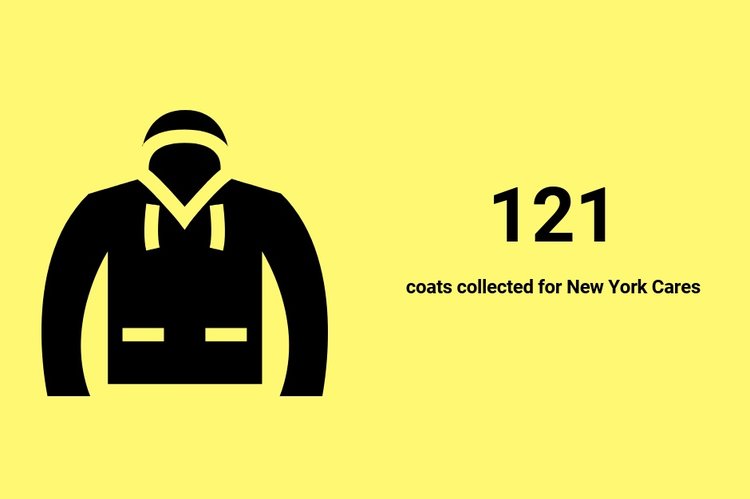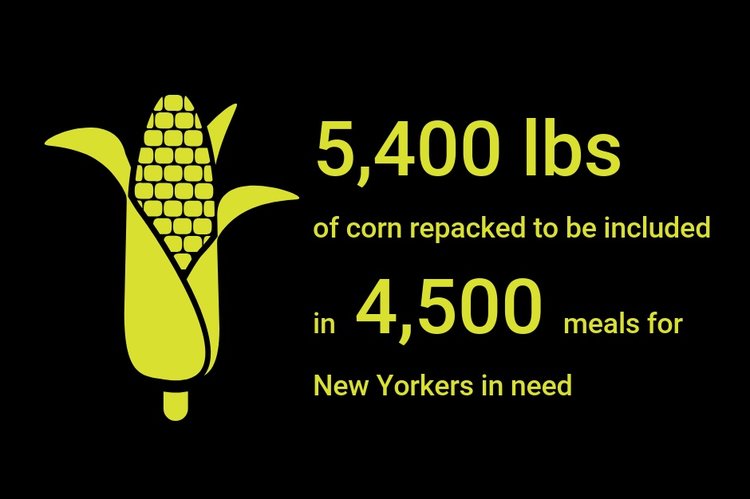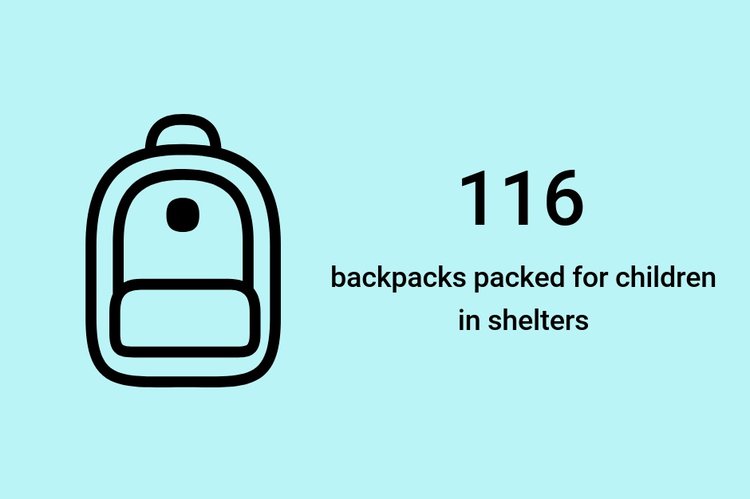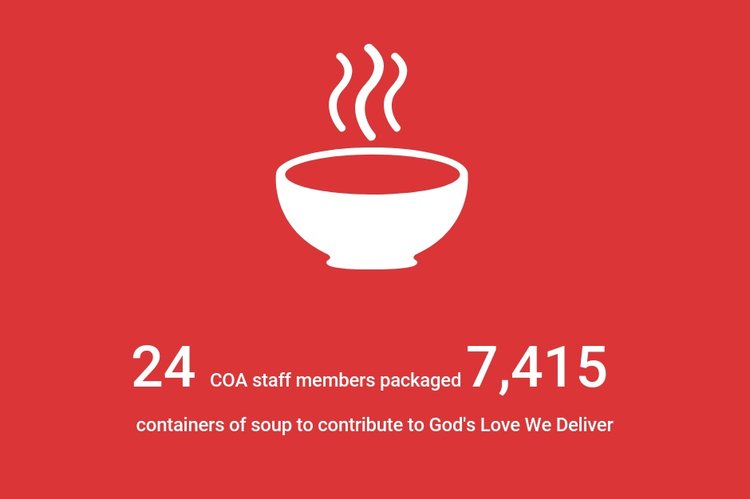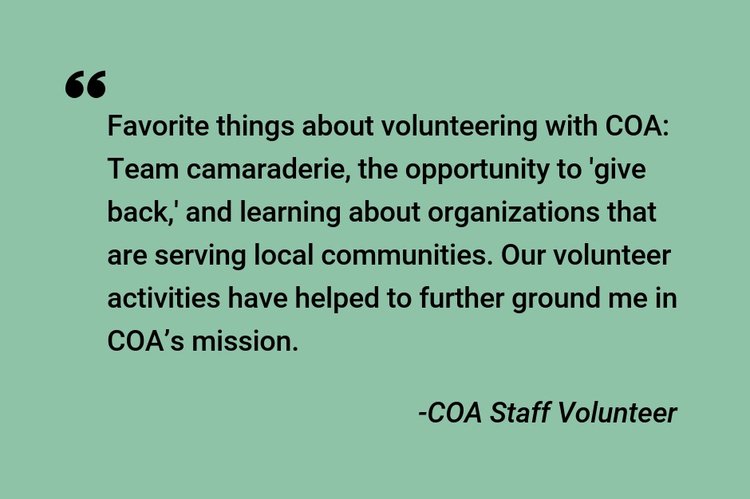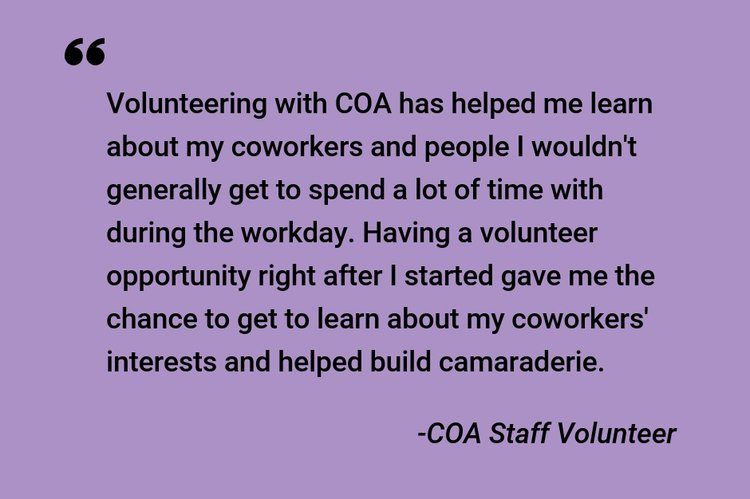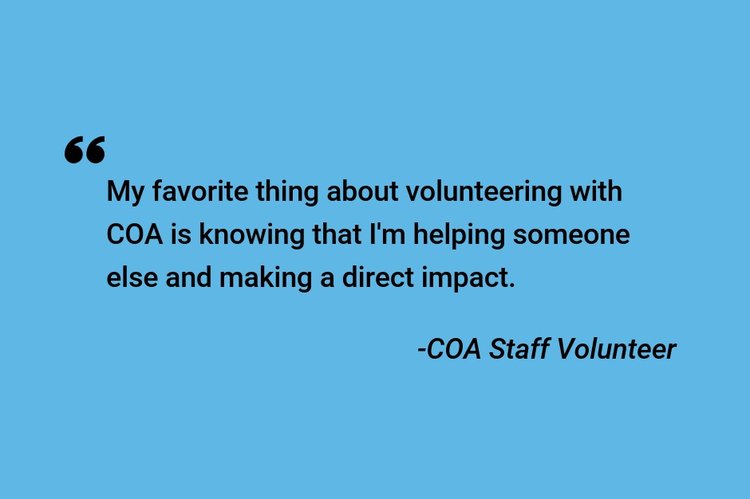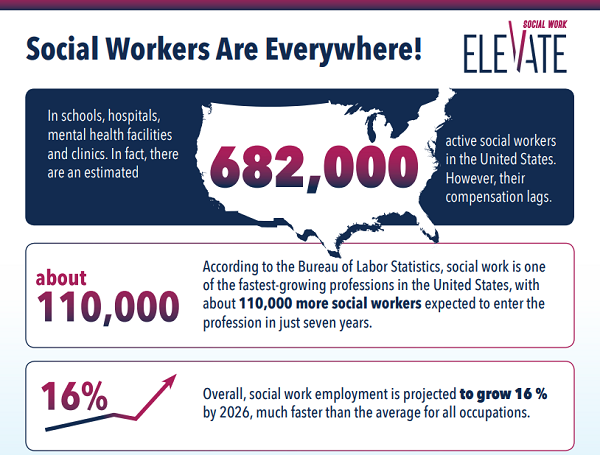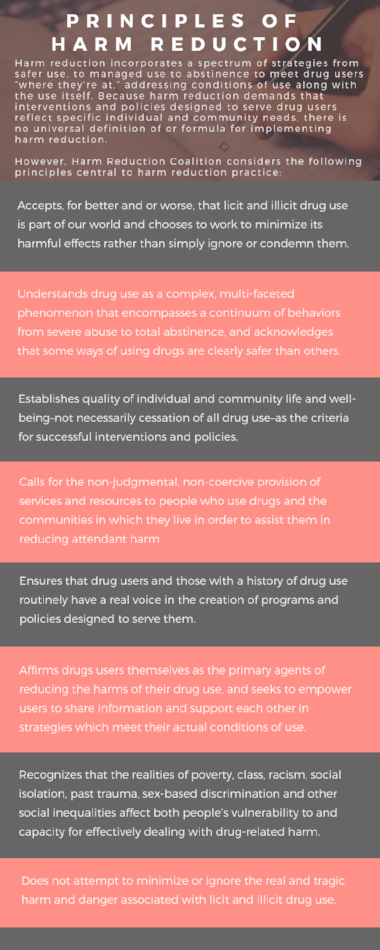At COA, volunteerism is the thread that binds us together and allows us to carry out our mission. Whether volunteers are helping our accredited organizations or running our site visits, COA would not function without them.
This is why we like to pause every April to celebrate National Volunteer Month. Established in 1974 by Presidential Proclamation, National Volunteer Month aims to both celebrate volunteers and unite the nation in increased volunteerism throughout the month. According to the Bureau of Labor Statistics, over 62 million Americans volunteer at least one hour each year, with the average amount of time equaling to approximately 50 hours per person (that comes out to about 3.1 billion hours of donated time!). Previously we have acknowledged Volunteer Month by writing about starting a workplace volunteer initiative and had a guest post from one of our many wonderful volunteers. This year, we decided we wanted to get a bit more personal. How does COA staff connect with our own volunteer initiatives? What impact does it have on the communities we serve as well as our own? What can others learn from our story?
In 2012, COA staffers spent a day on Staten Island, cleaning out a home affected by Hurricane Sandy. The devastation was sobering. It helped us to realize that we were eager to give back outside of our day-to-day work. This led to the formation of an interdepartmental group to spearhead employee volunteer opportunities, now known as the COA Volunteer Committee. Since its creation, the committee has coordinated drives, off-site activities, and in-house events.
How we’ve volunteered
Activities
The committee kicked off its efforts in 2013 by participating in “Repack in Hunts Point” with Food Bank for New York City during National Hunger and Homelessness Awareness Week. We traveled to the Food Bank’s Food Distribution Warehouse in the Bronx and were tasked with sorting, weighing, and packing corn to be distributed to food pantries and community kitchens throughout the five boroughs.
Another one of our favorite activities was volunteering with the Pajama Program in 2015. The program provides new pajamas and books to children in need nationwide, many of whom live in group homes, shelters and temporary housing facilities. Volunteers had the opportunity to read to children from Pre-K and second grade classes, share snacks, and hand out pajamas and a book for each child.
We loved working with kids so much that later that year we volunteered with Association to Benefit Children (ABC). We took a field trip to Battery Urban Farm and volunteers worked with two classrooms of three- and four-year-olds. We ate pizza. We rode the subway. We gardened… After we were done, we all needed a nap!
In 2017, we volunteered with Coalition for the Homeless, helping wrap presents for children living in their network of shelters. The gifts were distributed to 140 kids at their annual Kids Holiday Party and to other children experiencing homelessness throughout the city. This one definitely put us in the holiday spirit!
We did a second event in Spring 2017 working with God’s Love We Deliver, helping to prepare meals for individuals and families living with serious illnesses. We learned about their mission, put our hair nets on, and packed soup to be distributed across their network. This partnership has continued with a few additional volunteer opportunities in 2018, as well as planned events for this year.
Another organization we’ve worked repeatedly with is The Friends of Governors Island. We’ve enjoyed helping them weed, rake, and maintain landscapes for this beautiful island we are lucky enough to work near. This work allowed us to give back in a way that is outside the scope of our day to day responsibilities and is vital to sustaining the public green space.
Drives
In addition to off-site opportunities, the COA Volunteer Committee has also organized in different types of drives to support the work of various human service organizations. These have included:
- Collecting coats from staff and others in our building to support one of the largest coat drives in the New York City area, hosted by New York Cares
- Collecting essential winter items (such as scarves, gloves, and hats) for youth in the Safe Haven for Children program as part of Lutheran Social Services of New York, Inc.
- Collecting toys for children at the Dr. Katharine Dodge Brownell School (operated by Rising Ground, Inc.)
- Participating in a canned food drive for City Harvest
- Participating in a gift card drive hosted by Sanctuary for Families, a community-based organization for survivors of intimate partner violence, sex trafficking, and related forms of gender violence
- Participating in Project Back to School with the Coalition for the Homeless, collecting grade-specific backpacks and school supplies for youth.
In addition, we have an evergreen drive: With so many COA staff traveling across the nation representing COA at various conferences and events, we’ve made an ongoing effort to collect hotel-size toiletries to drop off at a shelter for survivors of intimate partner violence.
Our impact
Since 2013, COA staff have volunteered over 400 hours through the COA Volunteer Committee alone! We’ve seen the impact both internally and in our community.
Volunteering as an organization can give staff a forum to team build and bond, engage with the community, and increase morale.
When we polled staff about what they like best about COA volunteer opportunities, promoting team-building and building camaraderie came out on top. Staff also appreciate that the activities connect back to our mission and provide a space for us to get to know one another outside of the office. Another thing that we enjoy about our volunteer efforts? They give us the warm fuzzies!
At COA, volunteering has offered everyone a chance to give back, reconnect with our mission, and to “step away from our screens for a day to do good and spend time together while doing so.”
What we’ve learned
What are the barriers to getting a volunteer effort off the ground? Our staff report conflicting appointments and time away from the office as the biggest hurdles. Finding the time to volunteer can be a challenge when you have a full plate. The activities themselves, the environment, or the level of physical activity required can be other factors that change the response from “Count me in!” to “Maybe next time…”.
In the effort to keep our mission as a committee going and overcome these barriers, we’ve picked up a few tips and tricks to make our events more successful and have the greatest impact.
Schedule smart
Consider the nature of the event, time of year and weather in you planning – i.e. don’t plan an outdoor event if it’s commonly snowy that time of year. Keep in mind whether staff are typically on vacation or stacked with meetings on certain days. By making these considerations early, you’ll be able to maximize the number of staff that are able to volunteer for your event.
Find the right fit
When choosing a volunteer event for your organization it’s important to assess if there is an activity or event that is a particularly good fit for your organization. For example, our toiletry drive fit well with our frequent staff travels. You may also want to consider current events and needs in your area, like we did in our response to Hurricane Sandy.
Engage leadership
A key component of planning a successful volunteer event is getting buy-in from leadership to get the necessary permissions and gain their support and involvement. Engaging leadership at COA has enabled to us receive donations on behalf of the organization. Depending on the event and how your organization wants to contribute (time, items, $$$, etc.), there are a few approaches you can use to utilize that donation to its fullest. For our last backpack and school supplies drive, we recognized that backpacks were the most expensive item we were asking staff to donate, so we used COA’s donation to purchase backpacks.
Promote convenience
If you’re planning a volunteer event that will require staff to make donations, it’s important to make it as convenient as possible for them. If the expectation is that staff will bring things in from home, highlight the convenience of being able to clean out and drop off at their workplace. If staff will most likely need to purchase items for donation, we highly recommended setting up a registry. It provides specific guidance and easy purchasing options for staff and allows the organizer the ability to manage the items donated.
Offer incentives
Though the joy of donating and contributing to a cause is often enough to get people involved, incentives can be a great way to engage folks and reward their participation. When soliciting staff to participate in an off-site volunteer event we highlight the opportunity for out-of-office time, an option to dress down, and even snacks or lunch. We’ve also conducted raffles alongside events, entering all participants in a chance to win a gift card. Be creative and know what will incentivize your audience.
Send out reminders
People forget. Particularly if it’s 7AM and you’re trying to get to work. Make sure to send frequent reminders!
BONUS Tip: Even with reminders, we highly recommend allowing for some buffer time for sign up and donation deadlines (i.e. tell people the deadline is a few days before you absolutely need the commitment or donation).
Encourage volunteerism
If your organization doesn’t have the capacity to plan a specific event, create an avenue for staff to learn about volunteer opportunities. We place information on a white board in our communal kitchen and have a Slack channel solely dedicated to volunteer information. This way staff can get the information and choose to participate on their own time if they wish.
Whether you’re planning an event for your organization or doing something on your own, we hope you will get out there and volunteer this National Volunteer Month!
A big thank you to Greg Wright from the National Association of Social Workers (NASW) for this guest post!
Social work is a life-affirming and rewarding career field. It’s also one of the fastest growing in the nation, with over 100,000 people expected to enter the field in the next seven years. In spite of this, many social workers’ salaries tend to lag behind that of other helping professions like nurses, police, and high school teachers.
This year, during Social Work Month, the National Association of Social Workers (NASW) wants the public to pay more attention to this issue and spark a conversation on ways to end such pay disparity.
This year’s theme is “Elevate Social Work.” The theme has two meanings: We not only want to educate the public about how social workers uplift and empower members of our society, but also to let the public know that they must do more to support the field.
We are using a variety of tools to do this.
One is an infographic that sets out the facts. The demand for social workers is growing as our nation grapples with issues such as hunger, income equality, affordable housing, immigration, and the need for more mental health services. At the same time, the salary levels for social workers could improve. The infographic offers data on the average salary level of social workers by college degree and what sectors tend to pay social workers more. NASW hopes social workers and their allies can use the infographic to illustrate the case for higher social work pay.
In addition, we are offering a podcast series that features conversations with social work experts about the salary issue and what social workers can do to address it. Guests include financial advice guru Suze Orman, who earned a bachelor’s degree in social work; past NASW New York City Chapter President Robert Schachter, who helped lead a campaign in the city to boost salary levels; and Morgan State University Professor Michael Sinclair, who was New Jersey state coordinator for the Social Work p.r.n. national staffing service. We urge folks to listen to the podcast series and leave their comments on NASW’s Social Work Blog. NASW will be using these comments to weigh the next steps in addressing the salary issue.
Lastly, we have released a video public service announcement that looks at what our nation would be like if there were no social workers around. We hope social workers and their friends will share the video on their social media channels and ask their local TV stations to air it. The video will also be aired as an advertisement on YouTube throughout Social Work Month.

It is important to note that while NASW cannot act as a labor union and collectively bargain for social work salaries, we are working to improve those salaries in other ways. For instance, NASW supports the Improving Access to Mental Health Act, which offers clinical social workers more adequate Medicare reimbursement rates, as well as other legislation that would prompt our nation to invest more in its social work personnel.
Several NASW chapters have also supported initiatives for states to hire more school social workers, give social workers raises, or require government agencies to hire only qualified, licensed social workers for certain positions.
Of course more needs to be done to elevate the social work profession, and we know it will take all of us to do that. So during Social Work Month, take time to learn more about our campaign. Let us know what you think should be done to promote social work!
The views, information and opinions expressed herein are those of the author; they do not necessarily reflect those of the Council on Accreditation (COA). COA invites guest authors to contribute to the COA blog due to COA’s confidence in their knowledge on the subject matter and their expertise in their chosen field.

Greg Wright
Greg Wright is the public relations manager for the National Association of Social Workers (NASW), the largest membership organization of professional social workers in the world. Greg previously worked in public relations for the National Association of Manufacturers. A graduate of the University of Maryland, College Park, Greg had a long career in journalism, working for Gannett News Service/USA Today, Knight-Ridder Financial News, and Dow Jones News Service. Greg’s work has appeared in Essence Magazine, the Society for Human Resource Management, the Journal of Commerce, and PG Suite Magazine.
Welcome to the first in a new series of blog posts entitled Profiles in Accreditation!
The organizations that COA accredits are diverse in both the communities they serve and their reasons for seeking accreditation (or reaccreditation). Profiles in Accreditation will explore the accreditation experience through the perspective of these organizations. Through them, we can discover the value of accreditation, best practices, lessons learned, and recommendations.
Organization profile
Name: Lad Lake
Locations: Milwaukee and Dousman, Wisconsin
First Accredited: 2014
Reaccredited: 2018
Snapshot: Lad Lake has been evolving to meet the needs of Wisconsin’s most vulnerable children for 170 years. Serving more than 1,200 youth annually, the organization’s 300 staff accomplish its mission of “guiding the growth of at-risk youth to reach their potential and live responsibly” through four major program commitments: two residential care centers for youth who have experienced trauma from the child welfare and juvenile justice systems; alternative education for students with special learning needs; independent living services for youth “aging out” of the foster care system; and community services such as in-home therapy, specialized mentoring, and supervised visitation for parents and children.
Interview with Lad Lake
For our first Profiles in Accreditation post, we asked Lad Lake President and CEO Daniel O. Magnuson, MA, MSW to share his thoughts on his organization’s journey through reaccreditation. He emphasized how accreditation provided a framework for operational success, as well as the importance of having the entire organization–including the board–engaged with the process.
COA: Why was it important to Lad Lake to seek accreditation initially?
DM: We sought our initial accreditation in preparation for the retirement of a long-serving CEO; we wanted to position Lad Lake for improved impact and financial sustainability.
COA: What were some of the drivers for seeking reaccreditation?
DM: As we implemented the initial accreditation plan in 2014-2015, we also completed a comprehensive strategic planning initiative. COA’s accreditation framework helped us to focus and look at activities on an organizational level, which made the execution of our strategic plan more effective. Reaccreditation affirmed our internal sense that we were making significant progress in all domains of our performance, and in a dramatic fashion!
Additionally, accreditation provides Lad Lake with a competitive advantage with many of our stakeholders. This will be increasingly important as the federal Families First Prevention Services Act is implemented.
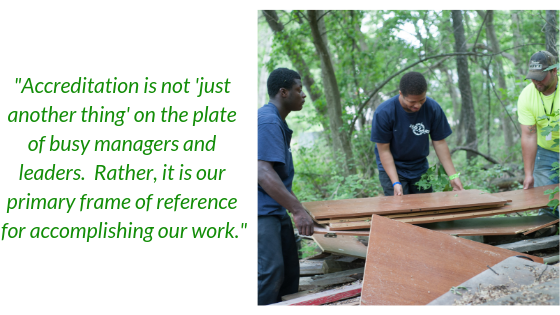
COA: What about the COA accreditation process made you decide to partner with us?
DM: Our partnership with the Alliance for Strong Families and Communities and our executive leadership’s deep connection with the Alliance network made COA the obvious choice for accreditation. It is the “gold standard” for our industry.
COA: What do you see as the main benefit of COA accreditation?
DM: COA accreditation provides Lad Lake with a framework for (and the discipline to stay focused on) our strategic priorities. It helps us to learn together, to adjust our approaches to achieve our intended impact, and to strengthen our financial sustainability in the face of changing market conditions.
COA: Were there any unexpected results after completing the Self Study and PQI process?
DM: The primary unexpected result was the degree to which Lad Lake’s management teams embraced COA accreditation, especially reaccreditation. The standards, the policies, and the procedures developed in our self-study and PQI processes have, for the most part, become the way Lad Lake does business. Accreditation is not “just another thing” on the plate of busy managers and leaders. Rather, it is our primary frame of reference for accomplishing our work.
Additionally, the COA accreditation and reaccreditation processes were completed in the face of very serious financial challenges. These challenges required the development and execution of a difficult turnaround plan. Rather than distracting our leadership from that plan, COA accreditation provided a disciplined process to focus our attention on the key drivers for our success.
As CEO, I do not believe our financial turnaround, improved quality and financial sustainability could have been possible without the discipline of thought offered by accreditation and reaccreditation.
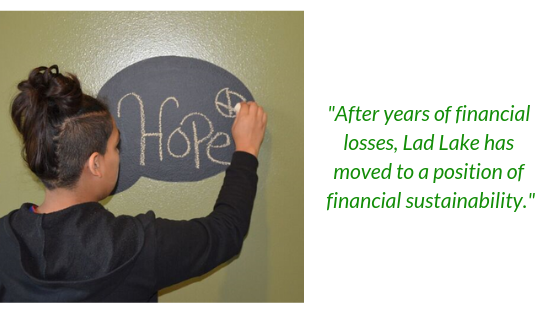
COA: Why was it important for you to have a high level of stakeholder engagement across your organization?
DM: One element of our organizational vision is to fulfill our mission with an “aligned, engaged, and happy workforce.” This can be a tall order in an industry with such challenging work and shoe-string budgets! The COA process, in concert with a clear strategic plan, helped us to articulate what we wanted employees to align and engage with. It also helped us to communicate those directions across our organization. This has grounded Lad Lake’s daily activities in a larger vision of improving the lives of youth and families in need.
COA: How has COA accreditation/reaccreditation impacted operational success at Lad Lake?
DM: Accreditation and reaccreditation has been transformative for Lad Lake. In concert with our updated strategic plan, COA provided a framework to operationalize and monitor our process improvements across all domains of our organization, from impact to human capital to financial sustainability to governance. A host of key performance indicators focused the work of the board, management, and staff.
The results have been extraordinary. All our programs now share common goals in safety, health, social support, and hopeful futures. Process improvement is closely tracked with client feedback and validated assessment methodologies. Findings inform refinements in program design. Risk management in many key areas has dramatically improved. After years of financial losses, Lad Lake has moved to a position of financial sustainability.
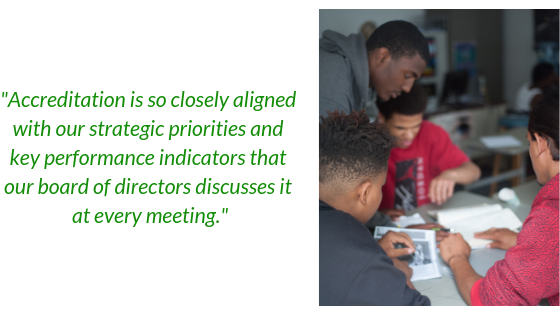
COA: How did you communicate the value of accreditation and engage the entire organization during the accreditation process?
DM: We did so in various ways. Firstly, many managers and supervisors were (and are still) involved in various teams devoted to quality improvement and risk management. Internal communication methods such as staff newsletters, email communication, and face-to-face meetings helped to extend the accreditation story to team members. Accreditation at Lad Lake is so closely aligned with our strategic priorities and key performance indicators that our board of directors discusses it at every meeting.
COA: At the board level, what were the driving factors for seeking accreditation?
DM: The board was particularly interested in accreditation to help it better understand and address the impact of the organization’s services on youth and families. The pending retirement of a CEO and the prospect of a new CEO coming aboard added extra urgency to Lad Lake’s initial pursuit of it.
COA: What was the biggest challenge for the board during the accreditation process?
DM: The board fully embraced accreditation. They understood its value and likened the process to quality initiatives and accreditation in their respective industries. Linking accreditation to our strategic planning and turnaround agenda required careful attention, but accreditation helped, not hindered, that process.
COA: What are the top three tips that you would give to an organization considering or currently undertaking the accreditation process for the first time?
DM: I would advise organizations to:
1. Embrace accreditation as the way you do business, not as an extra initiative to take on.
2. Embrace strategic planning. Find the right strategic planning process for you, and closely link accreditation with your strategic plan.
3. Communicate and engage your board of directors with COA. Many parallels may exist in their industries (e.g., Six Sigma, ISO 9001, Joint Commission, etc.).
Thank you, Lad Lake!
We would like to thank Dan for his thoughtful insights into the accreditation process and acknowledge the entire board and team for embracing accreditation and collectively contributing to the continued success of Lad Lake.
Do you have an accreditation story to tell?
Click here to tell us about it.
You could be the next organization we feature!
Active military and Veterans play an integral role in our everyday lives. Although we can’t always witness them in action or grasp the full breadth of their influence, we have confidence in their bravery and the safety they provide to our society on a daily basis. While we have this understanding, we also recognize that Veterans in this country often need support when they return home. Not only because of the inherent trauma of combat, but also because of the challenging economic situations that they often find themselves and their families in. We must continue to strive to do better by our Veterans. An example of progress in this area is the Supportive Services for Veteran Families (SSVF) program. This program addresses the varying needs of an individual Veteran and their family, by providing assistance with housing, transportation, child care, and the financial barriers that they may face.
SSVF was established in 2011 as a Rapid Rehousing and Homeless Prevention program to support homeless Veterans and their families in finding permanent housing and prevent homelessness for those at imminent risk due to the housing crisis at the time. In 2019, the U.S. Department of Veterans Affairs (VA) is making $326 million in grants available to providers through a competitive application process, in order to assist them with providing SSVF services. These services assist Veteran families with outreach, case management, and assistance accessing and coordinating other services that promote housing stability and community integration. The program has had several successes since its inception.
In 2015, Virginia Governor Terry McAuliffe announced that Virginia would be the first state in the nation to functionally eliminate Veteran homelessness. The philosophy underlying the state’s initiative is housing first — a policy that holds that providing homeless people with safe, supportive housing is a precondition for attending to the issues that caused them to slip through the cracks in the first place. Supportive services in permanent housing typically keep residents linked to social workers and include health services — many single homeless adults have some kind of serious physical, mental or substance abuse-related problem — and job readiness programs .
Virginia is not the only state that has seen successes with this population. SSVF, Phoenix, Arizona was the first community in the country to end homelessness among veterans with lengthy histories of homelessness. The tenet of the program as described by one veteran, “I’m coming up on nine months sober, and a big part of it is because I have a roof over my head.” The program allows participants to prioritize their recovery because they are no longer consumed with the fundamental human need of finding shelter.
Many capacities/elements are considered when applying to be a SSVF provider, one of which is a provider’s accreditation status. The Council on Accreditation is recognized by the VA as an approved accreditor of SSVF services. SSVF providers that are COA accredited are eligible to receive a three-year funding award from the VA, while non-accredited providers are limited to one-year funding awards. Recognition of specific accreditors is often used as a tool for oversight entities, in this case the VA, uses accreditation to meet/or exceed oversight requirements. The VA also allows SSVF providers to use their funding to pay for accreditation. This incentivizes providers to become accredited and allows the VA to verify that these providers have gone through a rigorous third party review by an accreditor. Essentially the VA uses accreditation as a tool to indicate a quality provider with quality services, services that are best equipped to support U.S Veterans and their families.
Jill Albanese, Supervisory Regional Coordinator at the VA, oversees providers of the SSVF program and has been with the department since the creation of the program. Jill graciously took time to explain how the VA’s recognition of COA accreditation played a role in them determining funding for these grantees. Check out our discussion below.
COA: What was the genesis of recognizing an accreditor for this funding?
JA: When SSVF was being created we wanted to find a way to monitor and oversee the program consistently within our limited resources. We looked into how other non-profit oversight entities were doing this work and began learning more about the accreditation process.
COA: Why is accreditation status a component of the SSVF grant?
JA: We wanted agencies to become accredited, however we did not want to mandate it and limit services in a community if a provider does not yet have an accreditation status. To further incentivize accreditation we allow providers to use SSVF funds to pay for accreditation and allow accredited organizations to be eligible for three-year funding awards.
COA: Were those incentives effective?
JA: Yes, I would estimate that about half of all SSVF providers are accredited.
COA: How has recognizing COA accreditation impacted the VA’s oversight of the SSVF program?
JA: We’ve seen increased consistency amongst accredited SSVF providers. In addition, we have consistent oversight practices for accredited organizations that allows us to reduce the duplicative work that we do to monitor the programs. We use an Accreditation Tool that shows our auditors which review steps would have been covered for them to achieve accreditation. We can spend less time monitoring those sections already reviewed under the accreditation process and more time focusing on offering technical assistance to our providers. It saves time for auditors and providers.
COA: Can you tell us about the roll out of the accreditation provision?
JA: Initially, we gave priority funding to applicants that were already accredited at the time. Then we worked with each accreditor recognized to determine specific service sections that we felt most appropriately fit the SSVF program. The accreditors then crosswalked their standards with our regulations and we were able to achieve further consistency between provider agencies.
COA: What have you heard from providers related to the accreditation process?
JA: I recently spoke with a provider about this, they described the process as totally worth it. In fact, this particular provider is excited to now be mentoring another agency through the accreditation process. I’ve also heard positive comments on the standards themselves. The process is rigorous, particularly before the Site Visit, but overall providers seem to appreciate the organizational change it creates.
COA: How do you think the accreditation process has impacted SSVF providers?
JA: Anecdotally, there seems to be an increased sense of organization about them. Particularly in day-to-day work we’ve seen providers transform their processes and procedures, which has an improved impact on the services delivered. It has increased the expectation of quality amongst SSVF providers, which has led to increased quality amongst the providers applying for SSVF funds.
COA: As the oversight entity, have there been any challenges to having an accreditation component for the grant?
JA: SSVF is a dynamic program that is constantly changing. Our mission is always the same, but the method changes, in some instances these changes can be rapid. It helps that the accreditors are ready and willing to make changes when that happens.
COA: Are there any components of accreditation that you find particularly valuable as an oversight entity?
JA: The individual governance standards, and policies and procedures are extremely helpful. It provides agencies guidance and structure. If a provider loses a staff member having these components of accreditation in place help them stabilize, which is good for Veterans.
COA: What impact do you feel the accreditation process has on the individuals served by SSVF programs?
JA: Ultimately, the individual Veteran has been able to expect a greater emphasis on consistent services. Anecdotally, the providers seem to run smoother operations.
COA: Has the role of an accreditor created any efficiencies for the VA as an oversight entity?
JA: Program review has become more efficient. Grantees are more organized for the process, which allows us to save time on things that usually require a lot of back and forth. It saves a lot of time day-to-day.
COA: Is there anything else you want to share that we haven’t covered in these questions?
JA: It’s amazing to see the differences from one year to the next with these providers. They’re eager to share their progress and the successes their clients have achieved.
Thank you!
We would like to take a moment to thank Jill for her time and insights, but mostly for the work she does every day to support Veterans in this country. COA looks forward to our continued collaborative partnership with the VA.
The Adoption and Safe Families Act (ASFA) of 1997 assures the permanency, safety, and well-being for all children and youth in the foster care system. These three tenets serve as the framework upon, which the COA accredited organization, Family Builders works to help find permanent, loving families for children and youth in foster care. Their Youth Acceptance Project (YAP), one impressive program among the many they provide, is designed to help one of the most vulnerable, overrepresented populations in foster care: LGBTQ and gender non-conforming children and youth. YAP provides a continuum of services to support LGBTQ and gender non-conforming youth and their families to ensure stable, permanent placements. Jill Jacobs, their executive director, talked with COA about Family Builder’s experiences with serving LGBTQ and gender expressive youth and how it led to the creation of YAP.
History and need
There are more than 400,000 youth in foster care in the United States, according to Adoption and Foster Care Analysis and Reporting Systems. A survey by the Williams Institute found that approximately 1 in 5 foster youth in Los Angeles identify as LGBTQ, twice the estimated percentage of youth not in foster care. Many LGBTQ youth in the child welfare systemare there because of rejection from their biological families as a result of making their sexual orientation, gender identity, or expression (SOGIE) known. This rejection places LGBTQ youth at a greater risk for negative life outcomes, including increased chances of health and mental health challenges, homelessness, lower self-esteem, illegal drug use, HIV and STI’s, depression and suicide.
LGBTQ youth often encounter challenges as they navigate the child welfare system. One challenge often encountered is foster families returning the youth to care after they come out; this leads to negative outcomes such as being less likely to achieve permanency and having multiple placements. Other challenges include being more likely to be sexually abused and more likely to face discrimination, including harassment and violence in group placements.
Research has shown that family acceptance is an important protective factor for the long-term wellbeing of LGBTQ and gender non-conforming children and youth. According to a report in the Journal of Child and Adolescent Psychiatric Nursing, accepting behavior (supportive responses, positive family interactions, open communication, expressing unconditional love) is positively correlated with a myriad of mental and physical health indicators including increased self-esteem, social support, and general health status, as well as decreased depression, substance abuse, and suicidal ideation and behaviors among LGBTQ youth.
Youth Acceptance Project (YAP)
In 2013, Family Builders launched the YAP, which has since grown to become an effective strategy to break down some of the barriers facing LGBTQ and gender non-conforming youth in the foster care system. The program is designed to keep LGBTQ youth safe in their family homes (family reunification/family preservation) and to advocate for safe and equitable permanency of LGBTQ youth when family reunification is not possible. Jill describes the intervention as “kitchen table social work”, working with parents and caregivers of children either in care or at risk of entering in order to increase acceptance of LGBTQ children among their support systems.
YAP Family Advocates are trained Masters’ level social workers that provide advocacy and therapeutic-style support to youth and their families around issues related to the youth’s SOGIE. Family advocates use a psycho-educational model and a harm-reduction framework to address the misinformation, resistance, fear, and grief that families often struggle with; ultimately moving families to a place of acceptance of their child with an emphasis on individualized, culturally responsive supports for caregivers and important adults. The project recognizes that caregivers often experience complex emotions, but with support and education they can become the affirming advocates that LGBTQ youth need. The model of intervention works by building on little changes that then culminate into bigger changes and acceptance, which creates better outcomes for LGBTQ youth. The result is families that become accepting and affirming of their children. The YAP intervention reduces the time that children spend in foster care and reunites children with their families.
YAP outreach
The work of The YAP is expanding across the country. Family Builders currently provides YAP direct services in two Bay Area counties: Alameda and Santa Clara, but is working on expanding their model. For counties and states outside of the Bay Area that are interested in developing a Youth Acceptance Project, Family Builders provides training and consultation services. Family Builders is currently working with Alleghany County’s Children, Family, and Youth Services and the Division of Cuyahoga County Children and Family Services to develop, integrate, and sustain best practices and programs that improve outcomes for LGBTQ and gender non-conforming children and youth in foster care.
Family Builder’s capacity to expand their program and consult with other agencies is due, in part, to the aid of a Children’s Bureau grant. The grant has allowed for them to develop an intensive program designed to prepare clinicians to deliver culturally-competent, ethical, effective support programs to gender expansive and LGBTQ youth and their families and offer follow-up consultation to help support clinicians and agency team members in implementing the program model. In addition to program implementation, the grant will also provide Family Builders the necessary tools and resources to collect data, ensure fidelity, and create a comprehensive evaluation for the YAP model.
Lessons for the field
Jill encourages practitioners to collect data on who is in their system, identify their specific needs, and use that information to inform the delivery of services. “The data has informed Family Builders that LGBTQ kids are overrepresented in our care so we need to include them in our conversations in order to best serve them.” According to Jill, all agency conversations, from supervisions, to case reviews, and file audits, need to have a SOGIE lens. By having conversations that include a SOGIE lens and using data to inform services, agencies are taking steps to ensure everyone in their care is honored, accepted, and affirmed for who they are. “If you’re not looking for LGBTQ kids in your care, then you’re not seeing them, and if you’re not seeing them, you’re harming them.”
This project is funded by the National Quality Improvement Center on Tailored Services, Placement Stability and Permanency for Lesbian, Gay, Bisexual, Transgender, Questioning, and Two-Spirit Children and Youth in Foster Care (QIC-LGBTQ2S) at the University of Maryland Baltimore School of Social Work. The QIC-LGBTQ2S is funded by the U.S. Department of Health and Human Services, Administration for Children, Youth and Families, Children’s Bureau under grant #90CW1145. The contents of this document do not necessarily reflect the views or policies of the funders, nor does mention of trade names, commercial products, or organizations imply endorsement by the U.S. Department of Health and Human Services.
Direct services in CA are funded by Alameda County Social Services Agency and the Walter S. Johnson Foundation.
The views, information and opinions expressed herein are those of the author; they do not necessarily reflect those of the Council on Accreditation (COA). COA invites guest authors to contribute to the COA blog due to COA’s confidence in their knowledge on the subject matter and their expertise in their chosen field.
Accreditation is a journey. One with a clear destination, but a less defined path. There are mile markers along the way; however, there isn’t necessarily one straight, easy road to the finish line. Is there a recommended route? Are there any anticipated hurdles? If you are tasked with leading the accreditation process for your organization, you may not know where to start. This is where COA’s Accreditation Coordinators come in.
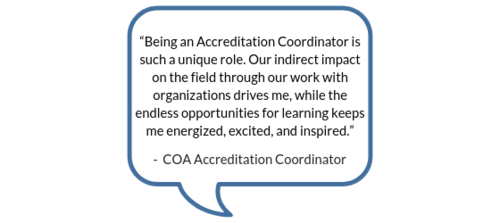
Every organization seeking COA accreditation is assigned an Accreditation Coordinator, a COA staff member that serves as a single point-of-contact throughout the accreditation journey. The role of the Accreditation Coordinator is unique to COA’s facilitative accreditation process. They work closely with the organization’s designated single point-of-contact, which COA refers to as the Primary Contact. Through this partnership, an organization obtains the support they need to navigate the road ahead.
Roles and responsibilities
Accreditation Coordinator
An Accreditation Coordinator works concurrently with a number of organizations. Their caseload can vary as well as the needs of each organization. The coordinators can also specialize in distinct accreditation programs or service types (Financial Education and Counseling, Employee Assistance Programs, Opioid Treatment Providers, etc.). Communication is a key element to this role. They’re responsible for answering questions, providing feedback on submitted documentation, and referring organizations to training and resources. Whether it’s to discuss specific documentation, standards, practices, or policies, they’re available on a daily basis to address inquiries from organizations. And because each organization comes with unique questions and circumstances, researching program models and administrative practices is also part of the work.

While the day-to-day routine of an Accreditation Coordinator involves providing tailored support to organizations, it is also valuable to note the role’s limitations. Accreditation Coordinators are not consultants and do not provide consultation to organizations. They can help Primary Contacts interpret the standards and answer questions, but are unable to dictate how implementation will look on the ground. Organizations are responsible for the application of the standards. And while they review and provide feedback on select pieces of evidence, specifically six key documents referred to as the Preliminary Self-Study (PSS), it is not within their role to review the entire Self-Study (aka all of the evidence that is required based on the assigned standards). The Site Review Team assesses the Self-Study prior to the Site Visit and will provide the ratings after conducting the on-site review.
Primary Contact
The Primary Contact is COA’s champion at the organization level and is in charge of spearheading the accreditation process. In this role, they’re responsible for engaging organization staff in all things COA. While the Primary Contact is the single point-of-contact, accreditation is by no means a one-person job. Accreditation is a huge team effort, from pulling together Self-Study evidence to preparing for the Site Visit, and the Primary Contact is the team captain. It’s no coincidence that we have repeatedly heard the role compared to “herding cats”!
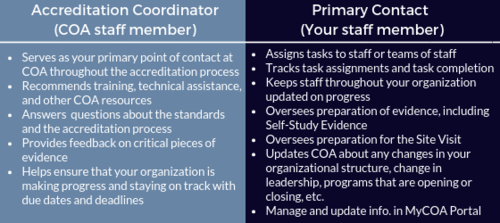
Exploring the relationship between the Accreditation Coordinator and the Primary Contact
COA’s mission is to partner with human service organizations worldwide to improve service delivery outcomes by developing, applying, and promoting accreditation standards. The relationship between the Accreditation Coordinator and the Primary Contact brings that partnership to life. The two work together throughout the accreditation process, from start (the intake call) to finish (the notification of accreditation). They’re there to kick off the expedition, advise you of the twists and turns, help navigate roadblocks, and ultimately make sure your organization hits all the necessary milestones en route to the final destination. Along the way, Primary Contacts should provide the Accreditation Coordinator with updates on their progress, highlighting successes and challenges. That information helps COA gauge the organization’s strengths and needs and informs the provision of targeted supports.
Learning about the challenges of navigating the process is vital to COA. We want to know about the unexpected obstacles in order to assist with readjusting your approach and preventing you from spiraling off course. For example, Performance and Quality Improvement (PQI) can be one major hurdle for organizations. As the Primary Contact it can feel daunting to try to implement a culture of PQI, especially if your organization doesn’t have the framework in place. As an Accreditation Coordinator, some of my favorite moments working with Primary Contacts have come from discussing the evolution of PQI. It could be talking through the development of a PQI committee (“Who should be on it?” “How often should they meet?”) or figuring out performance and outcome measures (“Can you explain outputs and outcomes again?” “What are some examples of operations and management performance measures?”). Standards and technical assistance inevitability guide the conversation, but it’s through this exchange that we learn how an organization goes about creating change. And isn’t that what it’s really all about? PQI helps an organization become stronger to better serve their clients and community.
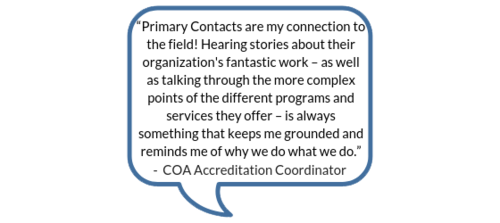
The relationship between the Accreditation Coordinator and Primary Contact is not one-size-fits-all. We are there to support in whatever capacity is most beneficial for the organization. For some this may take the form of structured monthly check-in calls, while others prefer Q&A exchanges over email. We recommend that organizations new to the accreditation process or new to the role of Primary Contact have more regular communication with their Accreditation Coordinator. Seasoned individuals may not need to rely on their coordinator as much; they remember the journey and have their path mapped out. Regardless of the frequency of contact, the door for communication is always open.
Tips for Primary Contacts
We know that serving as the Primary Contact is not an easy task. Often the work of accreditation is piled onto an already full plate. Here are some tips and tricks from COA’s team of Accreditation Coordinators:
- Use your Accreditation Coordinator as a resource. If you feel stumped or confused, don’t hesitate to reach out to your Accreditation Coordinator. Ask questions, it is what we are here for! That said, sometimes we get such excellent (and complex) questions that we need to consult with the team or the Standards Development department, which requires additional time. So it may take us time to get back to you with a response, but don’t worry; we will get back to you as soon as possible.
- Send us an email or schedule a call. The Accreditation Coordinator’s daily responsibilities are often collaborative – meeting frequently with organizations, our team, and other COA colleagues – which can sometimes impact our availability. We know Primary Contacts have busy schedules too. No one enjoys playing phone tag, it is best to schedule a call or send us an email. Our typical response time is 24 to 48 hours.
- Become friends with the MyCOA portal. We recommend that all Primary Contacts (and staff working actively on the process) participate in one of the regularly scheduled Intake Webinars in order to review all of the portal’s features and functionality. We don’t want to brag, but it is pretty cool! We encourage you to get familiar with the portal since this is where you will be completing the majority of the work. Check out the Step Pages, search for tools, and click all the buttons! Well not all the buttons.
- Attend a COA face-to-face training. There is no better way to familiarize yourself with all aspects of COA than attending either the in-person 2-day Intensive Accreditation Training or 1-day Performance and Quality Improvement Training. These in-person trainings provide Primary Contacts with an opportunity to learn from COA subject matter experts, meet COA staff and network with other organizations. We recognize this might not be a feasible option for all organizations due to limited resources and capacity. Therefore, we also offer a variety of complimentary live webinars and self-paced trainings covering similar curriculum. You can learn more and register through the Training Calendar.
- Don’t panic! This might be the most important tip on this entire list! The accreditation process is meant to be rigorous, but achievable. The goal is that you end the journey stronger than when you started. Change doesn’t happen overnight and it isn’t always easy, however, it is possible. The best advice for Primary Contacts is to not get overwhelmed; take the process one step at a time. Creating a work plan and communicating expectations to your team (don’t forget to enlist their help) is a good place to start. Have fun with it too! We have seen many primary contacts tap into their creative sides to invent games or enjoyable activities to get their team on board the COA train.
Training and resources
Want to know how to create a policy? We have a tip sheet for that! Want to know how to develop a strategic plan? We have a template (along with a self-paced training and blog post) for that! We’ve included just a few of the many resources that can help organizations on the road to achieving COA accreditation. We recommend exploring the full breadth of resources by accessing the tool search in the MyCOA Portal.
- Accreditation Learning Plan
- Getting Organized: Creating an Accreditation Workplan
- Preliminary Self-Study Fact Sheet
- Three-Part PQI Recorded Webinar Series
- PQI Tool Kit
- Preparing for the Site Visit
You are not alone
Many of us at COA have a social work (or social work adjacent) background, and the work we do to support Primary Contacts in their efforts to create change in their organizations, mirrors the work organizations do with their clients. We conduct an assessment. We create a service plan. We deliver supports and linkages to necessary resources. The makeup of our caseloads may be different, but we are all working towards a common goal – positive client outcomes and high quality services.
And as you learn from us, we learn from you. You are the change makers, advocating for those that you serve and making an impact on your communities. For many of us, the stories that you share and the work that you do are why we walk through the doors at COA. You are our direct connection to the field. Our collaboration allows us to gain a better understanding of service delivery and program models, as well as how the implementation of best practice looks on the ground for organizations of all shapes and sizes.
At the end of the day, an organization is ultimately responsible for their accreditation process, however, you are not alone on the journey. COA’s Accreditation Coordinators are there to support you and your team.
“I want to make the world a better place. I want to help vulnerable people in my community. I want a career where I feel like I’m making a difference.”
Are any of those sentiments familiar to you? They are to me and to many of the social workers I know. After all we were drawn to this profession for those reasons. After completing school, many of us found work in social services and therapeutic clinical settings. We take the skills we’ve acquired in life and in school out into our chosen field of practice – schools, non-profit organizations, mental health clinics – and we employ our strengths-based, person-in-environment framework to engage clients and communities in meeting their goals and improving their circumstances.
When we look at what we call our environments, however, our focus as social workers leans heavily on our social environments, and looks less at our natural environmental landscape and the impact that nature has on us as human beings and on our communities at large.
As a result, historically, social work has mostly seemed to leave the work of environmental justice to others. We’re doing so much already, we’re not superheroes! If we shift our thinking a bit however, and begin to examine the connection between the natural environment and our clients’ well-being, there is a strong case to be made that the environmental justice work that’s being done is more related to our mission as social workers than ever before.
Environmental justice
The concept of environmental justice isn’t new, but in my experience, it’s not something that is discussed very often within the framework of social work. Here’s a quick layman’s overview pulled together by this laywoman. The Environmental Protection Agency has defined this concept as “The fair treatment and meaningful involvement of all people regardless of race, color, national origin, or income, with respect to the development, implementation, and enforcement of environmental laws, regulations, and policies.”
From the social work perspective, the Council for Social Work Education developed a nuanced definition emphasizing not only the equal involvement and treatment of all people, but the right of all people to high levels of environmental protection: “Environmental justice occurs when all people equally experience high levels of environmental protection and no group or community is excluded from the environmental policy decision-making process, nor is affected by a disproportionate impact from environmental hazards. Environmental justice affirms the ecological unity and the interdependence of all species, respect for cultural and biological diversity, and the right to be free from ecological destruction. This includes responsible use of ecological resources, including the land, water, air, and food.” By emphasizing not only that all people have the right to be treated equally, but that all people have the right to be treated well, the focus is not only standing for equality. Its also standing up for all of us and our quality of life on earth.
When you begin to look at the connection between the natural environment and climate, and how this matters to social work, and the communities we serve, it’s pretty straightforward. Consider these scenarios: oil spills, air pollution, hurricanes and then of course Flint, Michigan. Way back in 1987, when some of us were in diapers and some of us were in hair bands, Toxic Wastes and Race in the United States showed that race was “the single most important factor in determining where toxic waste facilities were sited in the United States.” In the years since this study, mounting evidence has developed around the connection between environmental issues and racial and socio-economic justice issues and awareness of the intersection between these areas has grown. We now know that “people from marginalized and underserved communities are disproportionately impacted by climate change, drought, and pollution.”
The bottom line: this is another factor negatively impacting the communities we work to serve.
Nurturing through nature
So, that was a bummer. On the flip side though, I think it’s important to highlight that not only are the communities we serve disproportionately impacted when the natural environment is polluted, but that there are many potential benefits that can be gained from interacting with the natural environment. That is, of course, another reason for us to fight to preserve it.
The benefits of exposure to nature are real and spectacular. Whether it is walking in the forest to lower blood pressure or increasing ability to focus, or as this National Geographic article, This is Your Brain on Nature discusses, spending time outside to improve problem-solving, the benefits of exposure to the natural environment have been well documented. The field of ecotherapy for example, explores the therapeutic value of exposure to nature as an alternative tool for improving mental health. Programs like the Fresh Air Fund and Outward Bound provide opportunities for participants to gain skills and experience interacting with nature through immersive programming. And for those interested, COA’s research-based standards for Wilderness and Adventure-Based Therapeutic Outdoor Services outline best practices for implementing services based on this premise.
Social workers are natural helpers
Most of you reading this are probably aware of the unique skill set of social workers, but nevertheless, let’s take an opportunity to remind you (#notsohumblebragalert): social workers are known as strong empathizers, communicators, advocates, and organizers. Those skills are critical in not only traditional social work settings, but valuable in almost any work setting — traditional or non-traditional. And so while we often examine the concept of person-in-environment, (this blog has discussed the impact of built environments), how often do we specifically include our ecological or natural environment? If we choose to use these skills in the environmental justice realm, think of the power that could have to shape not only our built environments, but our natural environment as well. In that regard, a relatively new field, being referred to as Green Social Work, has developed around the emerging realization of the connectedness between our natural environment and our quality of life.
For social workers, how exciting is it to think about how we can use those advocacy skills to fight for access to clean drinking water? We can use our communication skills to break down what can feel overwhelming and hopeless (what if we looked at the way people use aversion of fear as a form of denial not only in our clients’ personal lives, but in regard to these global environmental concerns as well — hello, coping skills 101). And we can use our social justice lens to examine the need for equality not only in regard to social equality, but in regard to natural resource equality.
It’s worth looking at the following statement within the context above — “Social workers should promote the general welfare of society, from local to global levels, and the development of people, their communities, and their environments. Social workers should advocate for living conditions conducive to the fulfillment of basic human needs and should promote social, economic, political, and cultural values and institutions that are compatible with the realization of social justice.” That’s the NASW Code of Ethics in regard to Social Workers’ “ethical responsibilities to the broader society.” It goes on to say that in regard to social and political action, social workers “should engage in social and political action that seeks to ensure that all people have equal access to the resources, employment, services, and opportunities they require to meet their basic human needs and to develop fully.” It’s hard to argue that clean water, air, and land are not part of that tenet.
Team green: How your organization can make a difference
So, what should we do? Take a hike? Well, in the literal sense, YES! In the figurative sense, NO!
As social workers, as leaders of our organizations, as human beings on this planet — starting from our favorite strengths-based perspective — are there ways your organization already takes steps to reduce the environmental impact of its daily operations? Examples might include instituting a recycling program, using environmentally friendly products, and/or reducing water and energy consumption. This is a great start! Give yourself a goldish-green star. To formalize this, if you haven’t already, you might consider creating a Green Team of interested employees who want to work on environmental initiatives for staff inside and outside of the office. Many benefits of this can overlap with those of an employee volunteer initiative, if you have established one of those. Speaking of which…we already discussed the benefits of having an employee volunteer initiative when we explored ways the principle of corporate social responsibility (CSR) might be applicable to social service organizations on this blog. If this is something that you have implemented or are thinking about doing, it’s great to consider the opportunities to partner with environmentally-focused organizations. It switches it up from your day-to-day work, and might lead to future collaboration. At the very least, it exposes your staff to environmental activism and provides support in a needed area.
More broadly, CSR programs often encompass “a company’s sense of responsibility toward the community and environment (both ecological and social) in which it operates.” Viewing your for-profit or non-profit organization through this lens, as an entity with responsibility for the community and the environment in which you operate, it’s important to consider all ways in which you operate within, and have an impact on, the broader environment. While it may not be the ideal motivator, there is certainly a case to be made that there is an overlap between some of these efforts and your financial bottom line (hello, lower paper and energy bills). As a social service provider, you are already contributing to educational and/or social programs. Are there ways you can examine your impact on the environment as well?
The end of the rainbow is green
The point of this isn’t to scare you, overwhelm, or green wash you. The hope is that this emphasizes perhaps a new, personal connection between two traditionally disparate areas of justice, and makes us think about some ways in which they truly intersect. There is a case to be made that social workers are uniquely equipped and also ethically bound, to include environmental justice in our framework, even if it means expanding our purview of what it means to be social workers. Because at the end of the day – what are we fighting for, if not a better world, in every sense of the word.
P.S. One final note: if all of that isn’t moving you to take action, if you, like me, like brunch, maybe this will.
It is comforting to believe we know ourselves, our community, the universe, and our place in it. How else could we get out of bed every morning? That said, we must admit that much of our knowledge is inherited or built on an imperfect (and sometimes dangerous) foundation of experience and a priori reasoning.
a priori (a pri-o-ri): relating to or denoting reasoning or knowledge that proceeds from theoretical deduction rather than from observation or experience.
This is what excites me about data. Can we call it salvation? When collected and analyzed properly, data removes our subjectivity and can offer a neutral, reliable view of the world – if only a miniscule slice of it. Data is the heart of COA’s performance and quality improvement standards, and drives human service providers to continually monitor performance and investigate flagging or abnormal measures. Being deep in the data revolution, we now have unprecedented access to data about the world outside of ourselves and our organizations – critical for human service providers who have a special mandate to know and respond to the communities they serve.
The following are some of my favorite sources of public data relevant to human service providers. May you find refuge and transformation within them!
Data USA
The U.S. government collects lots of data. Lots of it. And most of it is publicly available – though likely raw, disorganized, and inaccessible to anyone without the skills to process it. Data USA connects to these sources of government data and makes them consumable by all:
- Natural-language generation translates data into plain, simple statements; each page feels authored by a human hand.
- Beautiful visualizations show trends over time or communicate complex datasets.
There’s a whole lot here, too: data on universities, colleges, and education opportunities; demographic data on cities, counties, ZIP codes, and states; job and employment data; medical and healthcare data; and more. Enter in your city’s name and see what happens. But Data USA does something remarkable by using its data to create local, state, or national benchmarks. For example, its natural-language generation algorithm produces this statement about Polish speakers in Chicago, IL:
When compared to other census places, Chicago, IL has a relatively high number of residents that are native Polish speakers. In 2015, there were 49,464 native Polish speakers living in Chicago, IL, approximately 9.4 times more than would be expected based on the language’s frequency in the U.S. more broadly.
Honestly, there is so much here. I recommend setting aside 30 minutes to deeply explore this unbelievable service.
How can human service providers use this data?
Research the demographic profile of your city, state, or ZIP code to ensure your client engagement practices are culturally nuanced. Are your materials translated into all local languages? Is there an area of the city more likely occupied by your target clients and so more deserving of time and resources?
Compare your client demographic data to the demographics of your service area. Is it possible that one or more groups are missing out on your services?
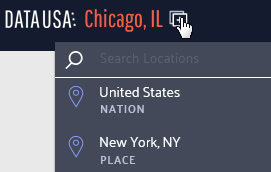
Use the compare function to analyze the differences between your service communities; to compare locations, click the icon shown below and select another location for comparison.
Individuals seeking services have often been fighting a long, lonely battle. Bolster your intake process by sharing relevant community data with service recipients to contextualize and destigmatize their experience. For example, a substance use treatment program could use the Excessive Drinking Prevalence measure found in the Risky/Harmful Behaviors section when serving individuals struggling with alcohol dependency.
Learn about basic measures of health and safety such as insurance coverage, medicare enrollment, and prevalent health conditions via the Health & Safety section of each location page.
Discover broader economic trends like this chloropleth on the poverty rate by county across the nation.
Nonprofit Finance Fund’s State of the Sector Survey
Since 2009, the Nonprofit Finance Fund (NFF) has run the State of the Sector survey to engage nonprofit organizations across the nation about their financial security and beyond: challenges facing their organization and their clients, opportunities they see in the next year, their use of program metrics and outcomes data, and more.
The 2018 survey results were affirming and surprising in equal measure. I’m not surprised that offering competitive pay is a top challenge reported by respondents, but that 67% felt the U.S. government made their clients’ lives harder? That’s shocking.
Want more? Tiffany Langston, Associate Director of Knowledge & Communications at NFF, provided a wonderful synopsis of the report, its function, and their findings in Data for Change: Nonprofit Leaders Raise Their Voices about the State of the Sector.
How can human service providers use this data?
Benchmarks are woefully scarce in the nonprofit/human service sector. Compare your organization’s performance to other nonprofits using many of the financial health measures found throughout the report. And, use the filters at the top to narrow the results to organizations like yours.
Start a conversation by reviewing the survey data with your team as either an element of your annual/strategic planning or simply as a team building exercise. Pause and reflect on each relevant question: what is the state of your organization and how could this impact your ability to deliver quality services? Do the findings reflect your neck of the woods? Why or why not?
Have an honest conversation about your organization’s theory of change, logic model, or outputs and outcomes measures. Are you, like 41% of respondents, operating without a theory of change or logic model? Do you, like 21% of respondents, not collect outcomes measures? How will this impact your ability to win grants in the future?
Leverage this data in conversations with policy makers and funders. Does your organization, like 60% of relevant respondents, receive late payments from your state? How does this inhibit or complicate your operations?
United States Census Bureau
The majority of the data output from the Census Bureau is aimed at researchers and other government entities and often not presented in an easily-consumable form. I recommend joining the Census Bureau’s mailing list for regular updates on gems like The Opportunity Atlas. This interactive map shows “the average outcomes (e.g., earnings) of children who grew up in each neighborhood in America, by demographic subgroup (race, gender, and parental income).”
Their Infographics & Visualizations page also has several interesting offers.
How can human service providers use this data?
Basic data on the communities served by human service organizations often reaffirm what front-line staff already know. But, being able to communicate these characteristics using hard data from respected institutions like the Census Bureau can bolster grant proposals, marketing collateral, and appeals to donors.
Forms 990 Data
How could we not talk about that shining ray of transparency, the Form 990? Let’s go beyond GuideStar and look at some fascinating services utilizing and transforming this data into information.
Citizen Audit
Citizen Audit makes the Form 990 look good. Traditional Form 990 data is accessible within a modern search interface and without learning what each schedule means (that’s 2 hours of my life I’ll never get back).
open990
Another beautiful interface for exploring Form 990 data. The layout is a bit simpler than Citizen Audit and shows a year by year comparison of all relevant data points by default.
ProPublica’s Nonprofit Explorer
Though less feature-rich than the services above, ProPublica’s Nonprofit Explorer provides quick and easy access to the text or raw XML versions of an organization’s Form 990 – great if you’re hunting for something in particular and want to execute a single page find across all data.
IRS Master Business File
For you pros out there, the IRS provides a download of all tax-exempt entities. These worksheets, divided into geographic regions (you can also download state-specific versions), contains the most recent Form 990 data on all tax-exempt entities.
How can human service providers use this data?
Benchmarks, benchmarks, benchmarks. Surely you are benchmarking your organization’s financial health against your past performance, but what about your peers? Dig up data on local organizations providing similar services and see how you compare.
Ask questions like:
- How are our financial ratios compared to our competitors?
- How does our CEO’s wage compare to other nonprofits like ours?
- We have 35 board members. Is that normal?
Find other organizations across the country providing similar services (for benchmarking or collaboration) using the NTEE code. The IRS categorizes all tax-exempt entities using this code; it’s a three character code where the first character, a letter, indicates the broad service area while 2 following digits reflect a narrower categorization of services. Find your NTEE code (most human service organizations have a P or F as the leading character), then find others with that same code and a similar revenue size. Use the resources above to dig into their 990 data.
Learn the ins and outs of your own organization – the 990 is typically comprehensive and is always a rewarding read. You might be surprised about what you discover!
Have you utilized any helpful data resources? If so, feel free to share them with us in the comments section!
These recommendations herein are those of the author; they do not constitute a formal endorsement by the Council on Accreditation.
When the Family First Prevention Services Act (H.R.253) was passed, it recognized that the best placement for children is in the least restrictive setting. This is also true for undocumented children in the custody of the Office of Refugee Resettlement (ORR).
In that regard, since 1997, the Flores Settlement Agreement has defined the rights of these children. In essence, it obligates the government to keep the children in the least restrictive setting and sets standards for their care. Recently, however, the Departments of Homeland Security (DHS) and Health and Human Services (HHS) have put forth a proposal to withdraw the agreement.
The agreement was never meant to be a de facto law so much as a framework, and in the original agreement there was a sunset clause expiring the agreement after 5 years provided the government implemented the terms of the settlement as federal regulation or Congress superseded it. Neither has happened. In fact, in 2015 the settlement was expanded to include all minors who come across the border without legal authorization (not just the unaccompanied ones who become custody of the federal government).
Despite the absence of the required federal regulation or congressional action, DHS and HHS have begun the process to withdraw the agreement. In doing so, families could be detained and placed in less regulated facilities, broadening the allowances for emergency loopholes for not meeting standards of care, and making it easier for government to revoke legal protections for unaccompanied minors.
This proposed rule change includes a comment period that ends November 6th, 2018 after which Judge Dolly Gee will determine whether the regulations are eligible to supersede the Flores Settlement Agreement. COA is urging interested parties to provide comments which put forth recommendations that emphasize the well-being of a child, and which ensure that migrant children receive trauma-informed and evidence-based care in the least restrictive setting.
The best practice of care for these children was established by the Flores Settlement Agreement and is contained in COA’s UC standards. It includes wraparound services to support their integration into society and placing them with kin or resource families in the most home-like settings. It has been two decades since the Adverse Childhood Experience (ACE) Study was conducted and the lessons learned have been indelible to the field: childhood trauma has long lasting effects. We cannot discuss the needs of this population without discussing the need for trauma-informed care.
So what can we do as human service professionals? Well, there are a few options:
- COA has put forth standards we consider best care for unaccompanied children. These standards are available our website. All comments and feedback will help shape the voice we provide DHS and HHS.
- Share your comments about what is best for children. Go to the Regulations.gov website for instructions on how to comment. Need some help with this? Here’s a resource to help you craft your response.
- Reach out to your representatives and ask what their plan is for the comment period and how they are defining proper care for unaccompanied minor children.
Thank you to Avi Rudnick, JD, MSW of Chicago House for this guest post!
In the early years of the HIV/AIDS epidemic in the U.S., nearly 100 activists met at the historic Baton Show Lounge to address the dire need for housing for Chicagoans living with AIDS; out of this Chicago House and Social Service Agency was borne as a not-for-profit providing a compassionate response to the disease. Chicago House serves individuals and families who are disenfranchised by HIV/AIDS, LGBTQ marginalization, poverty, homelessness, and/or gender nonconformity. Most of the individuals served have received messages in the past from family and friends that increase shame and stigma regarding behaviors and health status, which can result in a disengagement from services. It was important for Chicago House to choose a service philosophy that helped meet the service recipient where they’re at. Enter harm reduction.
What is harm reduction?
Harm reduction is a client-centered, trauma-informed approach that emphasizes safety and client self-determination. The philosophy dates back to work being done by activists, doctors, programs, and policy-makers in the 1960s and 70s as legal systems all over the globe began to take punitive measures against drugs. An early adopter of the philosophy was the Netherlands who put together commissions assessing whether strict law enforcement was best practice, referring to it as a “balance of harms.” It wasn’t until the 1980s that the collective efforts began to be referred to as harm reduction.
Harm reduction treats the individual as the expert in their own life, service recipients are given the agency to determine whether or how they want to change behavior. While harm reduction does not promote risky behavior, it also does not mandate sobriety as a barometer of success. A concrete example of how this plays out in the real world would be needle exchange programs. Needle exchange programs provide a safe, non-judgmental space for intravenous drug users to exchange their used needles for clean ones. They have been shown to significantly reduce the spread of blood-borne pathogens, such as hepatitis and HIV and, in fact, are associated with increased participation in treatment programs. Instead of focusing energy on the individuals’ sobriety, the programs provide resources to prevent the spread of disease and create a safe space for users. In addition to utilizing harm reduction approaches for addressing substance use, harm reduction is a philosophy that can be applied to many aspects of individual and community life, including, but not limited to: housing, health care, intimate partner violence, and mental health.
Why this philosophy works for Chicago House
Given the individuals served by Chicago House’s marginalized identities, it is not infrequent that one of the earliest and first hurtles is simply earning their trust and building rapport, that is Chicago House’s service providers’ first task. By prioritizing that relationship and putting the individual as the expert in their own life, the service providers help to even out the natural power dynamic that occurs and puts the individual at ease. Together the client and service provider can then explore the individual’s reasons for engaging in high risk behaviors and develop strategies and motivation to engage in safer behaviors (such as engaging in primary care and going on Pre-Exposure Prophylaxis). They inventory the individual’s coping mechanisms and enhance them. Harm reduction supports any positive change, thus putting the individual at ease that they are in a safe space.
Another reason harm reduction makes for a strong service philosophy for the population Chicago House serves is its relationship with trauma-informed care. Most of the clients served by Chicago House and Social Service Agency have experienced some form of trauma in their lives, so it is both fitting and necessary that the agency’s philosophy of care includes a trauma-informed approach to services. Client behavior is considered through the lens of someone who has experienced trauma and is honored as a coping and survival skill, highlighting the clients’ resiliency and ability to adapt which dovetails nicely with harm reduction’s strengths-based approach. Staff members work with clients to establish and maintain a sense of safety and mastery in their environment, something that is often times difficult for individuals with a trauma history, and recognize this as a basic building block for all other interventions.
Implementing harm reduction during service planning
Harm reduction philosophies are infused in the service planning process with clients and work to establish realistic goals regarding housing, health care, income, employment, education, substance use, mental health, etc. Chicago House approaches the creation of service plans with clients as a collaborative process, centering the client as the expert of their own life. While our funders may require that we include certain categories in our service plans, we work with clients on an ongoing basis to develop objectives and strategies to accomplish their goals. For some clients, a goal may be scheduling and attending an appointment with their HIV provider within the next six months, studying for the math portion of the GED exam, or going to the public aid office to apply for the Supplemental Nutrition Assistance Program.
Utilizing a collaborative harm reduction approach allows for changes in life circumstances and for our clients to move through the stages of change without being on the receiving end of shame inducing program requirements that increase fear and the possibility of discharge from programming. If a client does not achieve their goal within the six months outlined in the service plan, case managers use the opportunity to try different interventions, assisting the client in identifying strengths and new possibilities for different goals or a different approach to achieving the existing goal.
Harm reduction-related professional development
Chicago House regularly provides staff with professional development opportunities, such as brown bag lunches. One topic they facilitated recently was Sex Work: Reducing Stigma and Shame. Many of Chicago House’s clients have or are currently engaged in sex work. Instead of asking them to stop or making them feel bad about their choices, providers are being taught about the experience of sex workers so that they are more equipped to support the service recipients.
During this brown bag, staff watched a video of a Ted Talk presented by Juno Mac. She is a sex work activist who fights for sex worker rights and decriminalization of sex work. The discussion was centered on the implications of sex work for specific communities, particularly for trans women of color. Staff reviewed the report, Minority Stress and Sex Work-Understanding Stress and Internalized Stigma by the Sex Workers outreach Program (SWOP) as well as the National Transgender Discrimination Survey, Meaningful Work: Transgender Experiences in the Sex Trade. The brown bag talk wrapped up by reviewing the SWOP guide, Screening 101: Introductory Advice on Why Screening is Important and Some Basic Tips for Avoiding Bad Dates. This screening tool is information that can be directly relayed to the individuals served, providing strategies for reducing harm when engaging in sex work.
Additionally, all new staff members at Chicago House participate in a six-month philosophies of care training series, that includes an in-depth curriculum on harm reduction approaches, with two of the six sessions dedicated to trauma-informed care and motivational interviewing. All program staff members begin this training program within the first three months of employment for a total 12 hours of training on harm reduction approaches.
How other organizations can integrate harm reduction
- Develop and implement ongoing trainings for program staff and administration on harm reduction and related philosophies, such as trauma-informed care and strengths-based approaches.
- Infuse harm reduction language in all policies and procedures, reassessments, service plans, and psychosocial assessments, ensuring to eliminate language that can increase shame and stigma (i.e. not using the terms “clean” and “dirty” when referring to substance use).
- Eliminate the possibility of discharge or ineligibility based upon substance use, sex work, and/or criminal background by focusing on behavior and not stigmatized labels and identities.
The views, information and opinions expressed herein are those of the author; they do not necessarily reflect those of the Council on Accreditation (COA). COA invites guest authors to contribute to the COA blog due to COA’s confidence in their knowledge on the subject matter and their expertise in their chosen field.
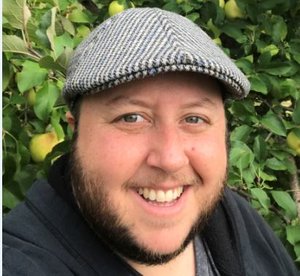
Avi Rudnick
Avi Rudnick, JD, MSW began his time at Chicago House and Social Service Agency as a supportive housing case manager in July 2013. Avi stepped into the role of Director of Scattered-Site Housing in February 2016. Avi also facilitates trainings for program staff on harm reduction, trauma informed-care and motivational interviewing. In addition to his role at Chicago House, Avi has been the coordinator of the monthly Name Change Mobilization at the Transformative Justice Law Project of Illinois since 2012. Prior to working at Chicago House and his involvement with TJLP Avi worked as a public defender in Portland, Oregon.

